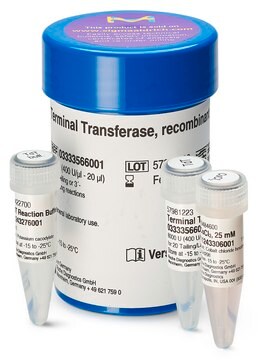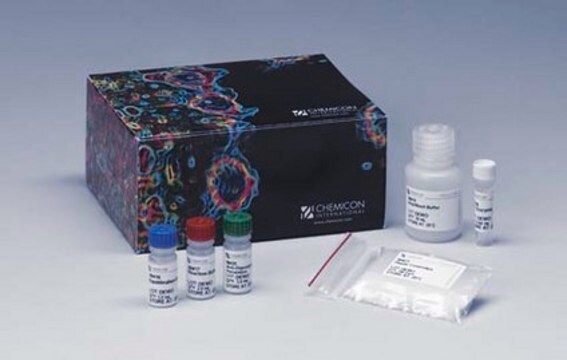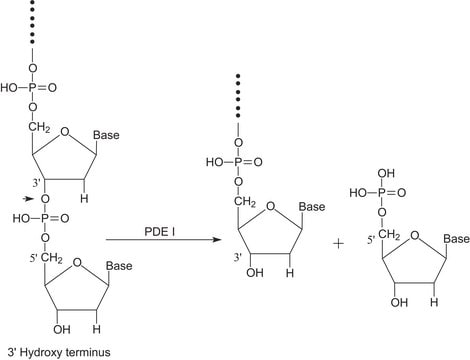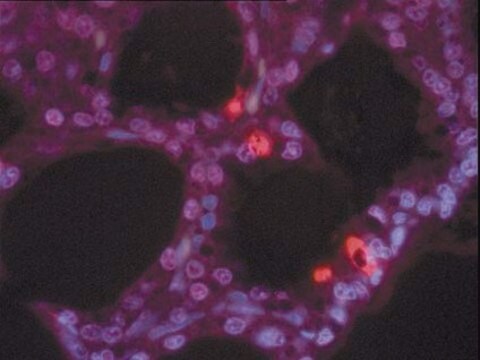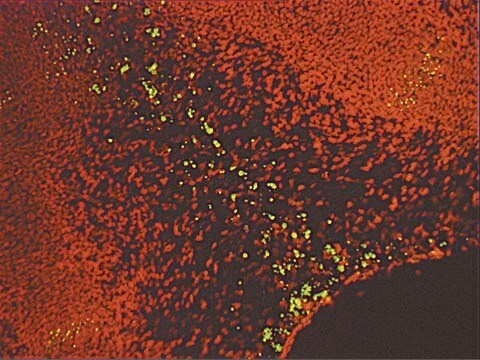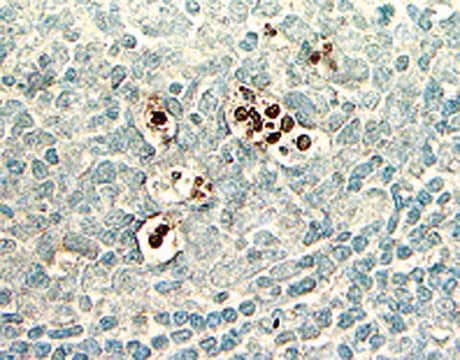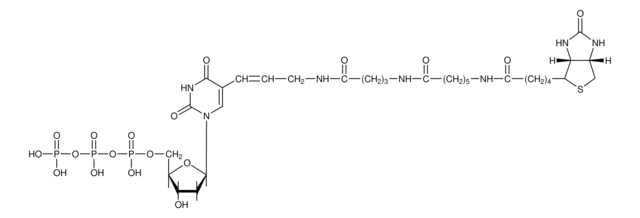S7107
ApopTag TdT Enzyme
ApopTag Terminal deoxynucleotidyl Transferase (TdT) is a recombinant enzyme intended for use in labeling the 3′-OH ends of fragmented DNA during apoptotic cell detection.
Sinónimos:
TdT enzyme, Terminal deoxynucleotidyl transferase
Iniciar sesiónpara Ver la Fijación de precios por contrato y de la organización
About This Item
UNSPSC Code:
12161503
eCl@ss:
32161000
NACRES:
NA.84
Productos recomendados
General description
ApopTag Terminal deoxynucleotidyl Transferase (TdT) is a recombinant enzyme intended for use in labeling the 3′-OH ends of fragmented DNA during apoptotic cell detection. Qualified for use with Apoptag In Situ Apoptosis Detection Kits (Catalog #s: S7100, S7101, S7110, S7111, S7160 and S7165).
ApopTag is a registered trademark of Serologicals Company.
ApopTag is a registered trademark of Serologicals Company.
Application
Materials Provided:
Each vial contains 300 μl of ApopTag Terminal Transferase (TdT) Enzyme.
Instructions for Use
Prepare labeling mixture as follows:
77 μl ApopTag Reaction Buffer (S7105 or kit component # 02)
33 μl ApopTag TdT Enzyme
Mix well and keep on ice. This reagent may be prepared in advance and stored on ice for no more than 6 hours. The Reaction Buffer - TdT Enzyme mixture is ready for use at the "APPLY WORKING STRENGTH TdT ENZYME" step in The Complete ApopTag Manual.
Warnings and Precautions :
ApopTag Terminal Transferase (TdT) Enzyme contains potassium cacodylate (dimethylarsinic acid) as a buffer. This material is harmful if swallowed; avoid contact with skin and eyes (wear gloves, glasses); wash areas of contact immediately.
Each vial contains 300 μl of ApopTag Terminal Transferase (TdT) Enzyme.
Instructions for Use
Prepare labeling mixture as follows:
77 μl ApopTag Reaction Buffer (S7105 or kit component # 02)
33 μl ApopTag TdT Enzyme
Mix well and keep on ice. This reagent may be prepared in advance and stored on ice for no more than 6 hours. The Reaction Buffer - TdT Enzyme mixture is ready for use at the "APPLY WORKING STRENGTH TdT ENZYME" step in The Complete ApopTag Manual.
Warnings and Precautions :
ApopTag Terminal Transferase (TdT) Enzyme contains potassium cacodylate (dimethylarsinic acid) as a buffer. This material is harmful if swallowed; avoid contact with skin and eyes (wear gloves, glasses); wash areas of contact immediately.
Packaging
1000 units/mL
Storage and Stability
Recommended Storage -15°C to -25°C.
Legal Information
CHEMICON is a registered trademark of Merck KGaA, Darmstadt, Germany
Disclaimer
Unless otherwise stated in our catalog or other company documentation accompanying the product(s), our products are intended for research use only and are not to be used for any other purpose, which includes but is not limited to, unauthorized commercial uses, in vitro diagnostic uses, ex vivo or in vivo therapeutic uses or any type of consumption or application to humans or animals.
signalword
Danger
hcodes
Hazard Classifications
Aquatic Chronic 2 - Carc. 1B
Storage Class
6.1C - Combustible acute toxic Cat.3 / toxic compounds or compounds which causing chronic effects
wgk_germany
WGK 3
Certificados de análisis (COA)
Busque Certificados de análisis (COA) introduciendo el número de lote del producto. Los números de lote se encuentran en la etiqueta del producto después de las palabras «Lot» o «Batch»
¿Ya tiene este producto?
Encuentre la documentación para los productos que ha comprado recientemente en la Biblioteca de documentos.
Los clientes también vieron
Po-Nien Tsao et al.
Development (Cambridge, England), 136(13), 2297-2307 (2009-06-09)
Although there is accumulated evidence of a role for Notch in the developing lung, it is still unclear how disruption of Notch signaling affects lung progenitor cell fate and differentiation events in the airway epithelium. To address this issue, we
Divya A Shiroor et al.
Current biology : CB, 30(11), 2166-2174 (2020-05-11)
Stem cells are continuously exposed to multiple stresses, including radiation and tissue injury. As central drivers of tissue repair and regeneration, it is necessary to understand how their behavior is influenced by these stressors. Planarians have an abundant population of
Nuestro equipo de científicos tiene experiencia en todas las áreas de investigación: Ciencias de la vida, Ciencia de los materiales, Síntesis química, Cromatografía, Analítica y muchas otras.
Póngase en contacto con el Servicio técnico